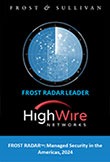If the key to resonating with your intended audience can be boiled down to any one consideration, it is that you as a reseller have to be able to see things from your perspective (and current) customers’ perspective. This might sound obvious, but when there is misalignment between how you see their needs and how they see them, solutions that seem like a perfect fit get overlooked–the worst missed sale is the one you could have made had it not been for suboptimal communication.
Managed detection and response (MDR) services are especially prone to suffering from miscommunication between you and your customer base because it can be tricky to encapsulate how they work and what they do in a way that immediately clicks. If that is the case, then what is the best way to market MDR solutions without getting deep in the weeds of technical specifications? The answer is an approach that emphasizes the IT security benefits to customers rather than the technical substance of the service itself.
Here are some tactics you can incorporate into your MDR marketing strategy that put customer IT security gains, particularly saved time and money, front-and-center.
Highlight the clear-cut benefits
Based on the IT security challenges their business faces, how will your customer see a shift in the effort and/or cost calculus, from an MDR solution, that rebalances their operations toward delivering their product? By envisioning what would, and should, stand out about what an MDR solution brings to their operational equation, the elements you need to emphasize and the language you need to speak in order to make the lightbulb go off become much clearer.
The quickest route to finding this viewpoint is to talk to current and former customers you’ve connected with and see what sold them (literally) on their MDR solution, or what realizations they made once they had their service up and running. You might be surprised to find out that the gamechanger for them is not necessarily the one you would have guessed.
Once you get a sense for how an MDR solution in general shifts the business equilibrium, drill down into what your MDR offering delivers in particular. For the Overwatch Security Platform-as-a-Service, that means
- Clear-cut reduction in detection and remediation time for your customers’ networks, and therefore an equally clear-cut decrease in costs, on account of industry-leading AI event parsing running under the hood
- Tailored solutions from your trusted brand, and the responsive and proactive customer service that your end-users have come to expect from you
- Transparent pricing models that let your customers count on predictable monthly costs, while also banking on downtime- and remediation-based lost revenue.
These are not only the primary benefits of the MDR solutions you can provide via your private-label or co-branded Overwatch Security-Platform-as-a-Service but also ones that naturally appeal to a wide range of enterprises, whether large or SME.
However, if your clients have more specialized needs, you also have the option of supplementing the above selling points with (or even leading with) the customization-derived, but no less impactful, advantages of Overwatch-powered MDR offerings.
The most significant among these are ready-made compliance options that can be plugged into an Overwatch-based product. This is perfect for a customer who is looking for an easy drop-in solution for network monitoring that also automatically catalogs the right data for regulatory audits and report filings.
This is a more prominent example of where customization can be an avenue for benefit-focused marketing, but it is by no means the only one. Take a critical look at the customizations and products you offer to see what might stand out to a prospective client. This is where you should let your creativity run wild.
Set your course by the 7 Ps
Looking at the seven big P words of marketing strategy, specifically, the ones that inform the method or medium through which you deliver your branding message can also reveal a wealth of possibilities.
Product: Remember that your products go beyond the solutions that you offer, but your entire output as a company, and everything you contribute to the field. You can reinforce your marketing efforts for MDR services via infographics, whitepapers, blog posts, and anything else you produce that isn’t your “product” per se. Make every word, chart, or graphic count, and never waste an opportunity to make conversions. You never know when a blog post will help your prospective customers put it all together.
Price: Knowing how much your customers are willing to pay for an MDR solution has clear relevance to your marketing efforts, but remember that price is more than a number. Overwatch’s per-user model makes quoting potential customers simple and transparent, and you can’t put a price on the consumer trust that affords you.
Promotion: Promotion is all about how you communicate with your customers. This is where the market research and tradecraft you’ve developed comes in, and only you will know best when, where, and how your audience consumes media. Use whatever tool in your toolbox works best for the task at hand, whether that’s advertising, discounts, public relations, or sales promotions. The key distinction that will guide this stage is whether the gap in your strategy is lack of awareness or of perceived relevance. Is it that your customers don’t know you have an MDR solution, or that they don’t think it would help them much? Your whole approach will, and should, hinge on the answer to this question.
Place: The “place” of your marketing is a more abstract way of referring to your distribution channel. Unless you’ve identified a single glaring deficiency in your strategic plan, it usually helps to use a combination of inbound marketing (e.g., blog posts) and outbound marketing (e.g., trade shows) to find businesses that you are ideally disposed to help. Most of the time, you are trying to grab the attention of the stakeholders in an IT security operation, namely, a business’s IT personnel and C-suite executives. For a value-added offering like MDR solutions, your marketing might be as straightforward as pushing upsells to existing clients who already use your sibling services that work all-too-perfectly with your MDR product. Think about the organizations your target IT security stakeholders belong to and the events they attend. What other complementary services do they use? Odds are your MDR will work harmoniously right alongside them, but that doesn’t mean they know that.
People: Who is the “face” of your MDR service? What makes that person or team of people special? Make sure they are all on the same page and reflect your brand values in your marketing. Consistency is important, as it is yet another means of building trust or damaging it if everything doesn’t all lock into place.
Physical evidence: If you have a way to collect metrics on how well your MDR performs, your marketing strategy is incomplete if you’re not collecting and capitalizing on them. Log, analyze, and present the results of how well your MDR services perform. What types of threats have they detected and prevented? How quickly does your team pivot from detection to response? Statistics speak for themselves, and oftentimes in ways that nothing else you publish can.
Process: How exactly does your service work? While detailed technical breakdowns don’t always get your message across, don’t count them out, either. If you think that’s what your customer needs to hear, make sure they hear it from you. For example, if their endpoints meet a certain specification that your private-label or co-branded Overwatch product knows how to natively tap into, that is something they may want to know when weighing a purchase.
Know your audience
Your audience should always be the guiding star for any marketing effort. While you will know them best, here are some suggested angles depending on the customer segment you are targeting:
- If your audience is looking explicitly for an MDR solution, front-load the tangible business benefits. If they understand the technical side of the equation, all the better, but don’t overwhelm them with technical specifications.
- Those looking for a managed security solution (MSS), but who would benefit from an MDR solution, are also solid potential customer targets. This likely means they are already looking beyond their organization’s walls, possibly because of insufficient in-house resources. By demonstrating value, you can essentially upsell them from a standalone MSS to an MDR solution.
- Potential clients who don’t know the difference between MSS and MDR might actually need the latter over the former. In this case, it is your job to steer them in the right direction, and you stand to gain their trust right from the get-go if you do so.
- Those looking for any kind of security solution make for ample potential for sales, but don’t mistake them for an easy sale! In many cases, they need the most attention and, most importantly, framing of how their business calculus changes with the right MDR solution.
For example, if a planned marketing campaign focuses mostly on businesses looking specifically for an MDR solution, then your marketing doesn’t need to explain the difference between MSS and MDR. Your job here is to focus on benefits you can offer, such as your pricing or response time.
On the other hand, if you’re marketing to SMEs, explain why they need an MDR solution and why it makes sense economically. Depending on your product lineup, it could also be marketed as a discounted, additional service offering.
Many businesses purport to offer MDR services but really don’t. If you find yourself in the position to point this out, seize on the opportunity. You can highlight features such as the real-time threat detection and response built right into Overwatch, and any proprietary technology you bake into it. We’re gradually nearing the point where MDR and MSS services will become interchangeable, but for now, make sure your customers know that they’re not. Being able to make that case demonstrates expertise.
In conclusion, if you want to make your message resonate when it comes to marketing MDR services, you need to understand the nuances of your target audience, what they understand about their security needs, and how you can gain their trust through informing and educating them. Meet them where they are, and guide them to learn more so they will feel comfortable taking the steps to become your customer.
If you want to discuss Overwatch’s MDR services, we’d be happy to share more insights. Email us at: overwatchsales@highwirenetworks.com.









Leave a Reply